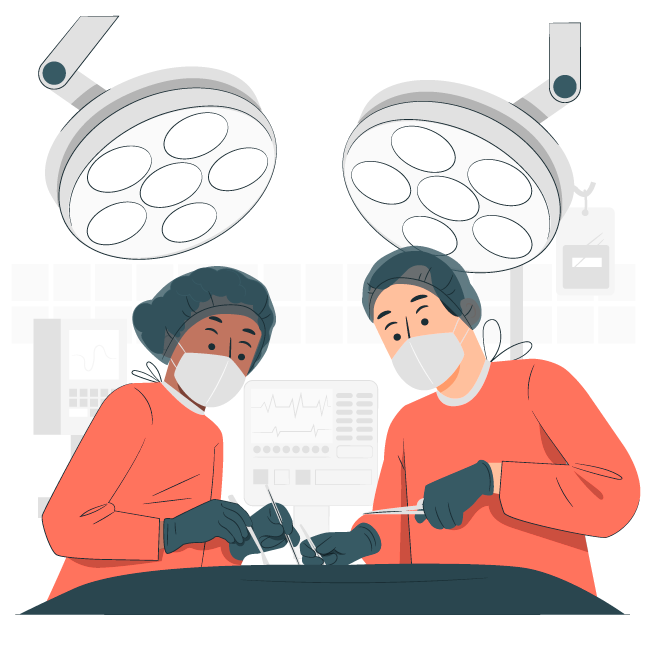
What is Laparoscopic Gynecology?
Laparoscopic gynecology is a minimally invasive surgical approach used to diagnose and treat a wide range of gynecological conditions. It utilizes a laparoscope, a thin, lighted instrument with a camera, inserted through a small incision in the abdomen. The camera transmits images to a monitor, allowing the surgeon to visualize the pelvic organs and perform procedures without large abdominal cuts.
Laparoscopic Gynecology Procedures List
Laparoscopy is a versatile technique used for various gynecological procedures. Here are some common examples:
Diagnosis:
- Pelvic pain evaluation
- Endometriosis diagnosis
- Uterine fibroid evaluation
- Ovarian cyst evaluation
- Pelvic inflammatory disease (PID) diagnosis
Treatment:
- Endometriosis ablation or excision
- Uterine fibroid removal (myomectomy)
- Ovarian cyst removal (cystectomy)
- Tubal ligation (sterilization)
- Ectopic pregnancy removal
- Pelvic adhesions removal
- Hysterectomy (uterine removal) with or without ovaries and cervix


Laparoscopic Gynecology Cost 2025
Due to the variability in factors affecting the cost of laparoscopic gynecological procedures, obtaining a definitive cost estimate can be challenging. To get a more accurate idea of the out-of-pocket expense, consulting with a doctor or healthcare provider in your area is crucial. However, to provide a general reference, a laparoscopic gynecological procedure in India in 2024 might range from ₹50,000 to ₹200,000. It’s important to remember that this is just a ballpark figure, and the actual cost could be higher or lower depending on your specific circumstances.
In addition to consulting with a doctor, you can also try contacting your insurance provider to determine if they cover any portion of a laparoscopic gynecological procedure. Knowing your insurance coverage beforehand can help you budget for the procedure.
Laparoscopic Gynecology for Infertility
Laparoscopy can be a valuable tool in diagnosing and treating infertility causes in women. Here’s how it can be helpful:
- Identifying blockages: Laparoscopy can help identify blockages in the fallopian tubes that prevent eggs and sperm from meeting.
- Treating endometriosis: Endometriosis can contribute to infertility. Laparoscopy can be used to diagnose and remove or ablate endometrial tissue implants.
- Adhesions removal: Pelvic adhesions can scar tissue that can impair fertility. Laparoscopy can remove these adhesions to improve tubal function.
Laparoscopic Gynecology vs Traditional Surgery
Laparoscopy offers several advantages over traditional open abdominal surgery:
- Smaller incisions: Less scarring and quicker recovery time.
- Reduced pain: Typically less post-operative pain compared to open surgery.
- Shorter hospital stay: Many laparoscopic procedures are outpatient or require only a brief hospitalization.
- Faster recovery: Patients can return to normal activities sooner.
However, laparoscopy may not be suitable for all cases. The surgeon will assess your specific situation and determine if laparoscopy is the most appropriate approach.

FAQs
2. What does Semen Analysis measure?
A semen analysis evaluates several key aspects of a man's semen, including sperm count, motility, morphology, volume, and pH level.
3. How is Semen Analysis interpreted?
Doctors compare your results to WHO guidelines. Normal results mean all semen parameters are within the normal ranges. Abnormal results require further evaluation.
4. What affects Semen Analysis results?
Semen analysis results can be affected by lifestyle (smoking, drugs, obesity), health (infections, medications), and environmental factors (toxins, heat).
5. How long does Semen Analysis take?
The semen analysis itself is a relatively quick process in the lab, typically taking a few hours. However, receiving the results can take 1-2 business days depending on the clinic's processing time.
6. What are the next steps after Semen Analysis?
The next steps depend on the results:
- Normal results: Further evaluation might focus on the female partner's fertility.
- Abnormal results: Repeat testing may be recommended to confirm the abnormality. The doctor will discuss potential causes and treatment options based on the specific findings. These might include lifestyle changes, medications, surgery, or assisted reproductive techniques (ART) like IVF or ICSI.
